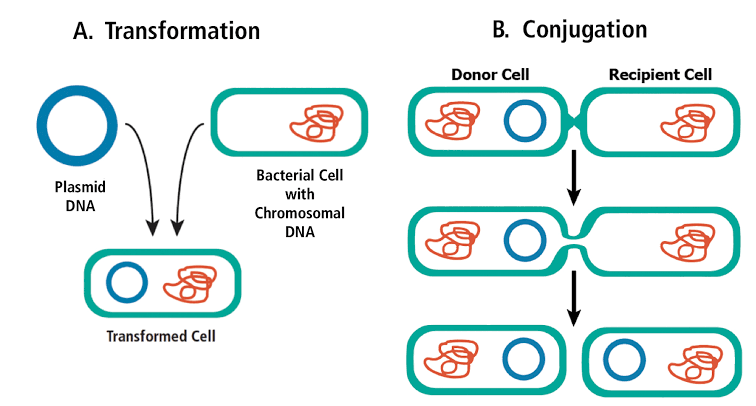
Molecular Mechanism of Transformation
Transformation is a process by which bacteria take up free DNA from their environment and incorporate it into their own genome. This can occur naturally in some bacterial species, such as Streptococcus pneumoniae, or can be induced artificially in laboratory settings. The molecular mechanism involves several key steps:
- DNA Uptake: Bacteria must first be in a competent state to take up DNA. Competence can be natural or induced through chemical treatments or electroporation.
- Binding and Transport: Once the DNA is taken up, it binds to specific receptors on the bacterial cell surface and is transported across the cell membrane.
- Integration: The incoming DNA can either exist as a plasmid or integrate into the bacterial chromosome through homologous recombination.
Conjugation of Conjugative and Non-Conjugative Plasmids
Conjugation is a form of horizontal gene transfer where genetic material is transferred between bacteria through direct contact, typically via a pilus.
1. Conjugative Plasmids
- Definition: These plasmids carry genes that enable their transfer between bacteria.
- Mechanism: They encode proteins necessary for pilus formation and the transfer process (e.g., Tra proteins). During conjugation, one bacterium (the donor) forms a pilus to connect with another bacterium (the recipient), allowing for the transfer of plasmid DNA.
2. Non-Conjugative Plasmids
- Definition: These plasmids do not have the necessary genes for self-transfer.
- Mechanism: They rely on conjugative plasmids present in the same cell for their transfer. Non-conjugative plasmids can be mobilized by conjugative plasmids during mating.
Generalized and Specialized Transduction
Transduction is another method of horizontal gene transfer mediated by bacteriophages (viruses that infect bacteria).
1. Generalized Transduction
- Process: During lytic infection, a bacteriophage accidentally incorporates fragments of bacterial DNA into its capsid instead of viral DNA. When this phage infects another bacterium, it injects this bacterial DNA, which may recombine with the new host’s genome.
2. Specialized Transduction
- Process: This occurs when a lysogenic phage integrates its genome into the host chromosome and later excises incorrectly, taking adjacent bacterial genes along with it. When this phage infects another bacterium, it transfers these specific genes.
Consequences of Recombination
Recombination has significant consequences for genetic diversity and evolution in bacteria:
- Genetic Variation: It introduces new genetic combinations that can lead to phenotypic changes.
- Adaptation: Bacteria can acquire antibiotic resistance or metabolic capabilities from other strains.
- Evolutionary Pressure: Recombination allows for rapid adaptation to environmental changes, influencing evolutionary trajectories.
Site-Specific and Non-Homologous Recombination
1. Site-Specific Recombination
- Definition: This type involves recombination at specific sequences within the genome.
- Mechanism: It requires specific enzymes (e.g., integrases) that recognize particular sequences, facilitating integration or excision events without requiring extensive homology.
2. Non-Homologous Recombination
- Definition: This occurs when there is no sequence similarity between recombining DNA segments.
- Mechanism: It often involves repair mechanisms that join broken ends of DNA molecules together but may result in insertions or deletions.
Mosaic Genes and Chromosome Plasticity
Mosaic genes are formed through recombination events that combine segments from different sources:
- Definition of Mosaic Genes: These are hybrid genes created from parts derived from different organisms or strains, often resulting from horizontal gene transfer.
- Chromosome Plasticity: Refers to the ability of bacterial chromosomes to undergo structural changes due to recombination events, leading to variations in gene content and arrangement.
This plasticity contributes significantly to microbial adaptability and evolution by allowing rapid acquisition of beneficial traits.







